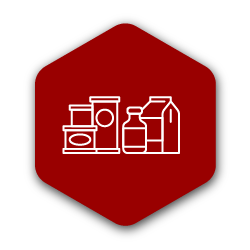Ensuring you offer the correct product mix at the right time, right place, at the right price, and to the right customers is vital to surviving in a competitive retail environment. By selecting a carefully planned and data-driven product mix for each of your clusters by employing dynamic clustering, you can ensure that you satisfy customer needs, increase sales, and build a great reputation.
What is a product mix?
A product mix is the assortment or variety of products offered by a retailer and can be described in terms of breadth, length, depth, and consistency.
Breadth or width refers to the number of different product lines or categories a retailer offers customers. For example, a large format retailer such as a department store or a hypermarket would have a broad product mix as they may offer many categories ranging from electronics to groceries. Meanwhile, a specialty or convenience store will have a narrow product mix, focusing predominantly on stocking fewer categories.
Secondly, the length of a product mix is determined by the number of products the retailer has within the categories they offer. A retailer such as Clicks or Dis-Chem will offer many different sub-categories or brands in the Hair Care category, for example, as they follow a Destination role.
Depth, on the other hand, describes the number of variants of one specific product type. For the Hair Care example above, a deep product mix would mean a retailer has many different variants of shampoo and conditioner. For example, it is common knowledge that pharmacy retailers such as Clicks or Dis-Chem stock all variants and different sizes of most Hair Care brands.
Lastly, the consistency of a product mix is the correlation between the products. In other words, how closely they are related to one another.
A product mix can be considered consistent when all the products in the assortment are more or less similar. Consistency can be measured in terms of product use and distribution. In a convenience store, for example, the Dairy category is fairly consistent as products therein such as milk and yogurt are similar in consumption and distribution.
A product mix, however, is not a one-size-fits-all decision. To cater to various customer segments with the right product mix for each, you may need to consider different product assortments and varieties for different clusters across your stores. This is referred to as dynamic clustering.

Product mix and its link to dynamic clustering
Dynamic clustering is the process of using data to group retail stores into segments based on the typical shopper of that store’s profile and to identify and predict changes in purchasing patterns.
In other words, looking at characteristics such as demographics; is this customer in a higher or lower income group, are they predominantly of a more mature age? Also, what are the physical characteristics of the store? What is its physical size and format? For example, is this a hypermarket, convenience store, and so on?
Once you have employed dynamic clustering, you can develop a product mix for each cluster specifically that speaks to that cluster’s specific target market’s needs whilst taking the physical aspects of the stores in that cluster into account.
For example, a retailer may have a cluster consisting of several convenience stores that are smaller in size and are in more outlying areas in the country where predominantly elderly consumers reside. These consumers may also fall into a lower income bracket.
For this specific cluster, the product mix can ideally be wide enough to offer these customers a one-stop shop for all the groceries they need but fairly short as these customers are not looking for specific brands. They are price sensitive so they will look for the best deal. The assortment will also be fairly shallow as they are not interested in many different varieties or sizes of a specific product.
How do you know if you have the right product mix?
1. What are the signs that you have the right product mix?
If you follow a dynamic clustering approach and in turn develop the correct product mix for your different clusters, you should see a steady increase in sales and foot traffic as customers become loyal to your brand and return to your stores.
That’s because they know that they will find the perfect assortment of a specific product category in your stores that they are looking for.
Customers are also less likely to walk out of your store because they could not find what they wanted. Dynamic clustering considers the specific customer's needs and wants and their shopping behavior.
For example, a customer who is looking for a travel-sized shampoo will go to a retailer that they know has a very wide and deep assortment of hair care products - who they know will also stock different sizes of shampoos.
2. What are the signs that you don’t have the right product mix?
On the other hand, not having the right product mix can harm your sales as customers will likely leave your store unsatisfied with your offering and decide to take their business elsewhere.
For example, a brand-conscious customer who buys a specific type of toothpaste will rather go to a competitor if they know your store does not have a very long and wide assortment of toothpaste and thus, not that specific brand.
By looking at data from your POS systems, you can identify which brands are the most popular with your target market for each cluster and ensure that the brand is stocked in those stores, especially if the shopper profile of those stores is a brand-conscious shopper.
Not having the right product mix will also decrease foot traffic and lead to poor customer loyalty.
Consistently failing to meet the customer's needs and expectations will inevitably result in a bad reputation as well. You need to make your target customers aware of what products you stock and what you can offer them to keep satisfaction as high as possible.
Unnecessary stock holding can also occur when clusters do not have an optimally developed product mix. Retailers might end up with stock that they can’t sell because the target market isn’t interested in it.
This can be avoided by looking at sales data and identifying which products and brands are the most popular in a certain cluster and focusing on stocking only those. Of course, a retailer can stock other products that aren’t as popular. If they do, though, they must be careful about how much they stock.
Conclusion
With DotActiv’s category management software, you can implement dynamic clustering using your data type of choice. Once you’ve identified your category-based clusters, you can create, edit, and maintain your clusters as they change according to industry trends and consumer purchasing patterns to achieve a competitive advantage.
Interesting in finding out more? Book a software demo with one of our experts. You can also browse our software and service solutions.
.jpg?width=290&name=Tanya%20(1).jpg)



